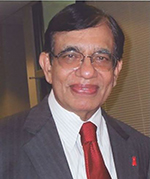
CANCER –Part X
The Final Journey

When 57-year-old Cecil was diagnosed with an early stage of cancer of his right kidney, he immediately underwent a nephrectomy, followed by adjuvant therapy, and was cleared of cancer. He remained quite well for five years and then one day while going for his morning walk with his wife, he felt a little short of breath. A quick chest X-Ray showed a few metastatic nodules in the lung and during the next few months, more distant metastasis affecting many areas, including liver, spine and brain were detected, in spite of anticancer therapy. His back pain, shortness of breath and fatigue steadily increased needing a lot of pain medications and oxygen. He looked grey and emaciated. That was the time both the patient and the physician decided to consult hospice.
In the life of many cancer patients, a day comes when the patient realizes that the cancer has spread diffusely all over the body and there is no hope for curing or even controlling the disease anymore. The sad realization that the end game has started dawns on the doctor and the patient. This is also associated with an increase in the symptoms, pain being a dominant one. It becomes clear that meaningful survival is not possible and the patients become naturally depressed and anxious. At this stage, not only they need symptom relief but encouragement as well. It is important that the patients know they are not alone in their final journey. Recurring symptoms like pain, nausea, vomiting and fatigue are enough for the doctor to find means of making the patient’s life happy.
In the beginning, cancer specialists and surgeons found it difficult to accept failure when they were unable to cure a cancer patient. Often, pain-relieving drugs were denied to patients saying it would lead to addiction and further deterioration and suffering. It took a kind-hearted nurse-trained British physician, Dame Cecily Saunders, to start the movement in 1967 to restore sanity and sanctity to the end-of-life care for cancer patients. These end-stage cancer patients were treated as pariahs both in oncology wards and their homes! In response to this injustice Saunders invented ‘palliative medicine,’ the goal of which was to give comfort care for terminally ill patients and help them die painlessly and gracefully.
‘Palliation’ simply means easing a terminally ill patient's pain and suffering and attending to their emotional and spiritual needs at the end of life. Dr. Saunders would physically remove these patients from the oncology wards and transfer them to a hospice center called St. Christopher Hospital in London. It would take another 10 years before hospice could cross the ocean and reach the U.S. In forming ‘hospice,’ Dr Saunders made an extraordinary contribution to alleviate unnecessary surgery and suffering for these patients. Now, hospice care is available in every county, provided by a team of healthcare professionals. Often, the care is given at home, which makes it easier for the patient and the family but is also available in hospitals, nursing homes and now special Hospice centers.
It took some more time before palliative care was established in India. Till then, end-stage patients suffered a lot of difficulties, often subjected to religious constraints and other influences. It took an anesthesiologist Dr. C. Rajagopal to establish palliative care in India called “Pallium” and now every state has palliative care centers. As he correctly points out, “Every difficult journey is made easier when there is someone to walk beside you.” How true! And his book, “Walk with the Weary,” has become wildly popular and is a lesson in humanity in health care. Another great read is Paul Kalanithy’s. book, “When breath becomes Air.” This is a touching memoir of a neurosurgeon’s valiant fight against advanced lung cancer and focuses precisely on the feelings of terminal cancer patients. And a third one is Atul Gawande’s “Being Mortal” that addresses end-of-life care and hospice care, and also contains Gawande's reflections and personal stories.
Palliative care is universally available and one day in the year is dedicated as “World Hospice and Palliative Care Day,” an annual unified day of action to celebrate and support hospice and palliative care around the world. Thanks to all these advances, a terminally ill patient can live out his final days in comfort and peace, while being attended by loving relatives and friends.
To be continued …
M.P. Ravindra Nathan, M.D., is a cardiologist and Emeritus Editor of AAPI Journal. For further reading, “Second Chance - A Sister’s Act of Love” by Dr. Nathan from Outskirts Press, can be found at www.amazon.com